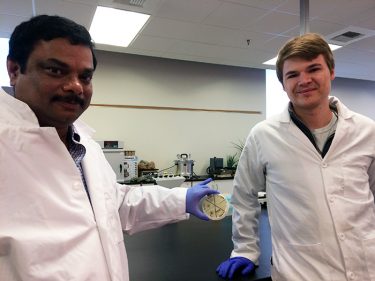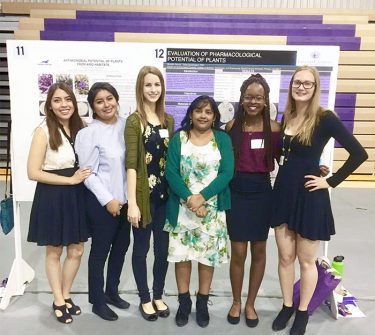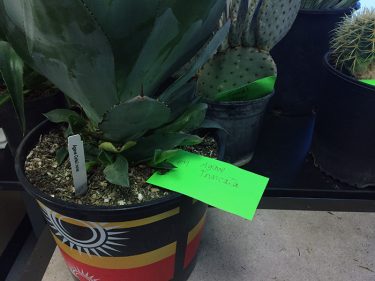
By Lana Sweeten-Shults
GCU News Bureau
In “My Big Fat Greek Wedding,” the family patriarch had the cure for everything: “Put some Windex on it!”
Grand Canyon University researchers aren’t exactly putting Windex on it, but putting a little pomegranate extract on it? Or aloe? Or maybe something a little closer to home -- a dollop of buckhorn cholla, desert marigold or ocotillo from the Sonoran Desert?
Could those desert plants be the secret to helping humans heal from certain ailments? Could they be the next big antibiotic in an age when bacteria are becoming more and more resistant to overused antibiotics? Could they be at the center of the next big drug?

GCU biosciences professor Dr. Ramesh Velupillaimani and GCU microbiology professor, and wife, Dr. Daisy Savarirajan are looking into that possibility with help from a team of about 20 undergraduate researchers who are part of the University’s Research and Design Program.
Velupillaimani, the project lead, has been researching pathogenic fungi called dermatophytes since 1994. He wanted to find plants that could brawl with these skin-disease-causing fungi – and win. But moving to Phoenix 20 years ago with Savarirajan got him thinking about the Sonoran desert plants unique to the area – an incredible diversity of plants that have gone largely unstudied when it comes to investigating their medicinal properties.
“Arizona is a desert, and desert plants seem to have a lot of defense because they’re in a very bad environment,” said Velupillaimani.
“The conditions in the desert are adverse,” added Savarirajan. “Everything is dry. There’s less moisture, and yet, these plants survive and thrive. So we wanted to see what exactly these plants are making to protect themselves against all the different microorganisms that live here in the desert.”
The two College of Science, Engineering and Technology professors, like many other scientists and doctors, are worried, in particular, about how microorganisms, such as MRSA (methicillin-resistant staphylococcus aureus), have become resistant to antibiotics because of the overuse of those drugs. What’s even more worrisome is that very little work is being done to discover new drugs to counter that resistance.
“In the battle of bugs vs. drugs, bacteria becoming resistant to all known antibiotics is only a matter of time. The quest for a cure is clearly a matter of life or death. The weapons that we have to fight against all of these infections is becoming less and less,” Savarirajan said. “And pretty much people are lost now. What do we do?”

So in 2016 – the same year GCU’s Research and Design Program debuted -- Velupillaimani and Savarirajan launched their research study to discover novel antimicrobial products from diverse desert plants. Currently, they are screening plants to see which ones produce antimicrobial products that would be safe and effective to use against drug-resistant microbes.
What cemented the project for the couple was their daughter’s second-grade science fair project, which won second place at the state-level science fair.
“We took the ingredients that were in there in the kitchen – garlic, cinnamon, turmeric,” Savarirajan said, and her daughter tested those common household spices. "The garlic showed significant antimicrobial properties. One of the judges happened to be a physician, and his son was battling an incurable fungal infection. Impressed with the result of garlic against bacteria, he suggested testing against fungal specimens and said that would be a big discovery."
“That made us think, OK, so there is a big need for this kind of research.”
Nature has been a source of medicinal products for millenia.
"Now researchers are just changing gears, I believe, and looking into more natural therapies," Savarirajan said, adding that the scientific community has not extensively studied desert plants for their medicinal properties, and it seemed to the GCU team that these new drugs might be found in plants growing in arid conditions.
Natural therapeutics
Due to no known side effects, plant-based therapeutics is experiencing increasing demand, Savarirajan said. The Bible describes some 30 healing plants, and, "Since time immemorial, medicinal plants have been the basis of a traditional system of healing in all parts of the world."

Student researcher Daniela Barrera is looking into some of the plants her grandmother has used.
“I come from a Mexican family, and so my grandma is really big on natural (treatments), using herbs and different kinds of plants if there’s an illness. So there are some plants that she has used her entire life and that her mother used and that she showed my mother to use. So I’m just looking into some of those to see if there’s actual science behind it.”
Sophomore biomedical engineering major Annaline Romero is investigating Mexican oregano, which grows wild in the Sonoran and Chihuahuan deserts, to see if it has anticancerous properties.
Like with Barrera’s family, “My family tends to use more plants (to treat ailments),” Romero said. “My father would say tomatillos would take your sore throat away.”
Fellow student researcher Nicholas Sever added, “In regards to the folk medicine we were talking about a little earlier, this is actually one of them. It’s called larrea tridentate (or the creosote bush, native to the Sonoran, Mojave and Chihuahuan deserts). It’s been recorded as being used by Native Americans in the Sonoran desert area in treating wounds and burns, so I was looking into that one.”
Student Braiden Harvey, meanwhile, is looking for plants that might have antioxidant properties, and possibly, cancer-fighting properties.
“With throat cancer, plants have shown, at least with personal stories, anecdotal stories, that they have been effective," Harvey said.
Emily Branch, a GCU student researcher who also works as an emergency medical technician, has been investigating aloe, curry and hornbeam and is combining them to see which combinations might create better results.
“I’ve gotten pretty good results combining them,” she said.
Collaborating with botanical parks
For the antimicrobial drug discovery project, the researchers have collected hundreds of plants that occupy just about every nook and cranny in the Lab 302 counter space in Building 57. They’re in quart storage bags and in pots and are dried and poking out of plastic bags, everything from Stenocereus thurberi, also called the organpipe cactus, to Lophocereus schotti, an ornamental pole-shaped cactus.
“There are hundreds of plants,” Velupillaimani said.

The team collaborated with Phoenix desert botanical parks, which have given the researchers samples. It can be difficult to identify the plants so, going through botanical gardens assures that the group is working with plants that already have been identified, though project team members also have been to the desert to collect samples.
Branch said, “Basically, we just collected a lot of plants and tested them and picked out the ones that actually show some results and then do further testing on those.”
Once a plant has been collected and identified, the team uses an agar diffusion test, or disc diffusion bioassay, to test the plant extracts.
The team has been testing combinations of plants, as well as different concentrations of the same plant, on such bacteria as Staphylococcus, Streptococcus and Salmonella.
They’ve seen promising results for antibacterial activity with pomegranate, Velupillaimani said. He added, "Out of several plant species tested, the leaf extract of Ephedra viridis, Anemopsis californica, Larrea tridentate, Artemisia absinthium, Cassia nemophylla, Lagerstroemia microcarpa, Myrtus communis and Moringa oleifera showed high inhibition against the growth of gram positive and gram negative bacteria."
Eventually, the researchers want to create a database using barcoding technology to identify the plants using their DNA. This will ensure consumer safety against counterfeit or adulterant drugs.
Savarirajan and Velupillaimani think being involved in a research project such as this gives students experience that will expose them to important aspects of health science research, especially in finding novel drugs to counter the imminent threat of drug-resistance among microbial pathogens. Another goal is to present their findings in scientific meeting forums, publish in peer-reviewed journals that will open the avenue for professional development, research collaboration with pharmaceutical industries, as well as internship and job opportunities for students.
The team has presented their work at GCU-based research symposiums and is heading to the American Society for Microbiology Conference in Las Vegas this April.
While many researchers are identifying Sonoran plants, “No one is identifying and isolating drugs from these plants,” Savarirajan said. “So in that way, this research project is pioneering work" -- work that is more scientifically sound than simply putting Windex on it.















